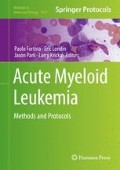Abstract
Targeted sequencing, in which only a selected set of genomic loci are sequenced, enables a much higher coverage of each target than what is obtained using whole genome or exome sequencing. Multiplex PCR offers a simple and affordable technique for specific capture of target regions and can be easily adapted to generate next-generation sequencing (NGS)-ready amplicons. Here we describe a multiplex PCR (MxPCR) approach for capturing 13 leukemia-associated mutation hotspots followed by MiSeq sequencing that enables robust detection of mutations with a variant allele fraction (VAF) as low as 0.8% (0.008) in blood DNA.
Access this chapter
Tax calculation will be finalised at checkout
Purchases are for personal use only
References
Kozarewa I et al (2015) Overview of target enrichment strategies. In: Current protocols in molecular biology. Wiley, Hoboken
Nguyen-Dumont T et al (2013) A high-plex PCR approach for massively parallel sequencing. Biotechniques 55(2):69–74
Quail MA et al (2011) Optimal enzymes for amplifying sequencing libraries. Nat Methods 9:10–11
Quail MA et al (2014) SASI-Seq: sample assurance Spike-Ins, and highly differentiating 384 barcoding for Illumina sequencing. BMC Genomics 15(1):1–13
Shen Z et al (2010) MPprimer: a program for reliable multiplex PCR primer design. BMC Bioinformatics 11(1):1–7
Qu W, Zhang C (2015) Selecting specific PCR primers with MFEprimer. Methods Mol Biol 1275:201–213
McKerrell T et al (2015) Leukemia-associated somatic mutations drive distinct patterns of age-related clonal hemopoiesis. Cell Rep 10(8):1239–1245
Ford AM et al (1998) Fetal origins of the TEL-AML1 fusion gene in identical twins with leukemia. Proc Natl Acad Sci U S A 95(8):4584–4588
Kyle RA et al (2002) A long-term study of prognosis in monoclonal gammopathy of undetermined significance. N Engl J Med 346(8):564–569
Grove CS, Vassiliou GS (2014) Acute myeloid leukaemia: a paradigm for the clonal evolution of cancer? Dis Model Mech 7(8):941–951
Busque L et al (2012) Recurrent somatic TET2 mutations in normal elderly individuals with clonal hematopoiesis. Nat Genet 44(11):1179–1181
Genovese G et al (2014) Clonal hematopoiesis and blood-cancer risk inferred from blood DNA sequence. N Engl J Med 371(26):2477–2487
Jacobs KB et al (2012) Detectable clonal mosaicism and its relationship to aging and cancer. Nat Genet 44(6):651–658
Jaiswal S et al (2014) Age-related clonal hematopoiesis associated with adverse outcomes. N Engl J Med 371(26):2488–2498
Laurie CC et al (2012) Detectable clonal mosaicism from birth to old age and its relationship to cancer. Nat Genet 44(6):642–650
Quail MA et al (2014) SASI-Seq: sample assurance Spike-Ins, and highly differentiating 384 barcoding for Illumina sequencing. BMC Genomics 15:110
Li H et al (2009) The sequence alignment/map format and SAMtools. Bioinformatics 25(16):2078–2079
Conte N et al (2013) Detailed molecular characterisation of acute myeloid leukaemia with a normal karyotype using targeted DNA capture. Leukemia 27(9):1820–1825
Nguyen-Dumont T et al (2013) Cross-platform compatibility of Hi-Plex, a streamlined approach for targeted massively parallel sequencing. Anal Biochem 442(2):127–129
Author information
Authors and Affiliations
Corresponding author
Editor information
Editors and Affiliations
Rights and permissions
Copyright information
© 2017 Springer Science+Business Media LLC
About this protocol
Cite this protocol
Park, N., Vassiliou, G. (2017). Design and Application of Multiplex PCR Seq for the Detection of Somatic Mutations Associated with Myeloid Malignancies. In: Fortina, P., Londin, E., Park, J., Kricka, L. (eds) Acute Myeloid Leukemia. Methods in Molecular Biology, vol 1633. Humana Press, New York, NY. https://doi.org/10.1007/978-1-4939-7142-8_6
Download citation
DOI: https://doi.org/10.1007/978-1-4939-7142-8_6
Published:
Publisher Name: Humana Press, New York, NY
Print ISBN: 978-1-4939-7140-4
Online ISBN: 978-1-4939-7142-8
eBook Packages: Springer Protocols

